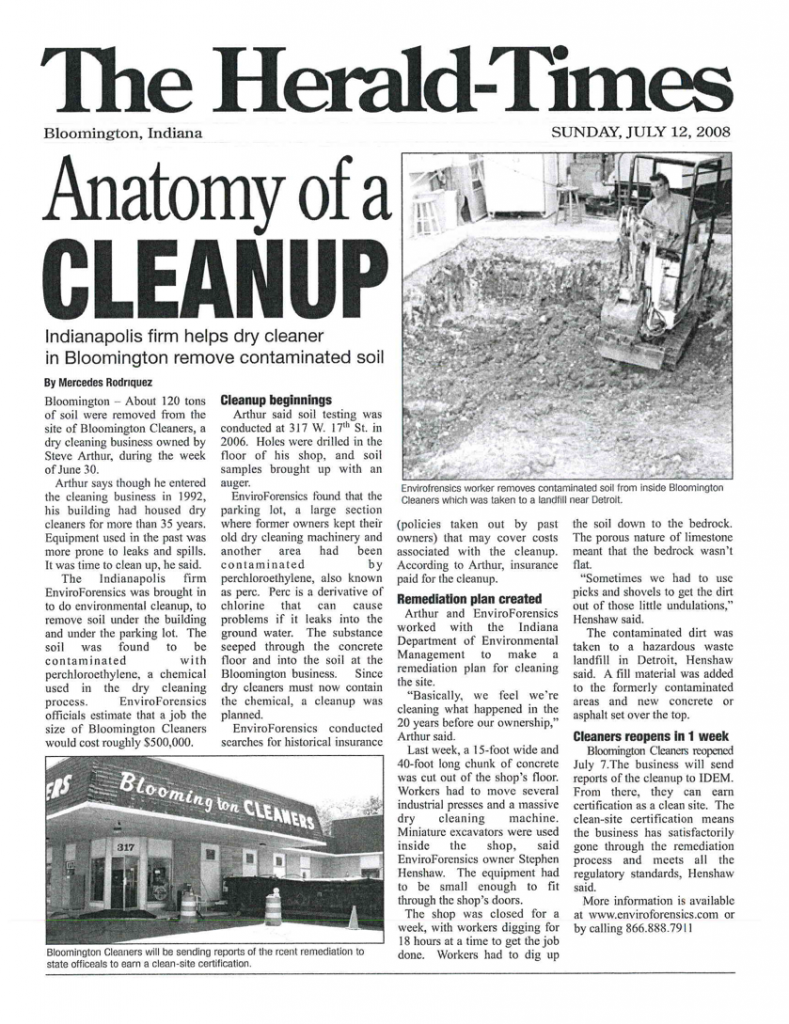Let’s say you’ve found solvent contamination at your dry cleaning facility and its impacted groundwater, soil and/or adjacent property. You are probably thinking, not only is it costly to address the contamination but it could also ruin my good business reputation.
Have you ever thought that cleaning up environmental contamination could be good public relations? It can, and it’s a matter of sharing the right message with your audience.
What does your situation look like?
Dry cleaners have to be careful in how they address their contamination issue. Most dry cleaner’s biggest concern is if they conduct an environmental investigation that they’ll discover their neighbor’s property has contamination on it, or that vapor intrusion is going into their neighbor’s home or business and their neighbors will sue them. While that may be a possibility, that’s not typically how it happens. When the environmental contamination issue arises, it almost always happens in reverse. A lawsuit is filed by a party or group of people against all of the parties that have owned the property or business where contamination is allegedly emanating from. It is rare that a dry cleaner conducts a cleanup and are then being sued. Typically, a real estate transaction of a neighboring business initiates the lawsuit against the former and current owners of the dry cleaning business and/or property. This means that proactively conducting an environmental investigation will lead to addressing environmental contamination on your timeframe instead of someone else’s. By the way, while PERC, a dry cleaning solvent, is considered a known carcinogen, it is generally very difficult to attribute a person’s adverse health condition to PERC exposure. For example, if someone that has cancer was exposed to PERC they have likely been exposed to other chemicals that are also carcinogenic; making the direct link between the alleged PERC exposure and the health effect more difficult to legally prove. Out of the hundreds of environmental investigations that I’ve been involved with, only a handful of sites received significant public attention. Most people, unlike dry cleaners, just don’t deal with environmental contamination as part of their daily life. For example, most people don’t think that their neighborhood gas station is involved with an environmental cleanup, but almost every gas station has been or is being cleaned up for a carcinogenic chemical called benzene. So, if nobody asks any questions about the investigation, you don’t have to volunteer any answers. However, this doesn’t mean that you shouldn’t be prepared with a public relations plan.
What should you do if you need to make a public statement?
If you find yourself needing to respond to public relation inquiries or questions, you need a positive message and you need to bring your employees on board with that message. You’ll also need to acknowledge that past dry cleaning practices were different than they are today. It’s true that in the old days most people didn’t even think PERC was harmful to people or the environment, and spent filters may have been placed in trash bins, or spills may have been washed into the sewer or storm drain–don’t go into detail about the old practices. Instead acknowledge old practices and let them know what you’re doing to address the issue. You want to give them a warm feeling about you.
Make An Honest Statement
Depending on where you are at in the environmental process, an example message could be: “In the past, PERC was not considered harmful and older machines weren’t really designed to be as protective of the environment as they are today. We are taking the necessary measures to investigate the potential contamination and will be proactive in addressing the situation.” If you’ve conducted an environmental investigation that confirms PERC contamination, go on to tell them that a small amount of PERC was found in the soil and/or groundwater and that you are working with the regulatory agency to make sure there are no impacts to people or the environment. If you know you are going to conduct environmental remediation, state that you are working with the regulatory agency to restore the soil and/or groundwater to levels that protect people and the environment. You may want to enroll the assistance of your regulatory agency project manager. Most regulatory agency staff understand the hardships that small business owners face when dealing with environmental investigations and will gladly work with you to present complicated technical issues in a down to earth and unthreatening manner.
Learn how Mercury Cleaners shared their environmental cleanup with their customers.
Create A Fact Sheet
In some states, a fact sheet may be required to be sent to all residents living within a given area of your property. It is best if you can be involved with the creation of the fact sheet language. The fact sheet should have the following information:
- A discussion about the contamination and what is known;
- A description of planned work and technical reports;
- Contact information for you, your consultant and the regulatory agency representative;
- Where reports can be found about the site; and
- A location map identifying the site and the surrounding neighborhood.
In addition, the fact sheet should be published by the agency or be put on the agency’s letterhead to show that it came from an official source. Your employees should also be briefed and told to direct any questions to you. It would be a good idea to have copies of the fact sheet at your place of business in case your customers are curious. As your investigation progresses, the fact sheet should be updated and highlight the progress made to solve the problem along with the future work schedule for cleanup of the contamination.
An Example of a Dry Cleaner Being Proactive
Dry cleaners could make a really big splash by inviting the media to cover the story. One of EnviroForensics’ clients was very high profile and is a success story of a dry cleaner who turned their environmental cleanup into good PR.
The dry cleaner invited a newspaper to cover the environmental remediation of his property. A journalist showed up with a photographer and wrote about the progress that was being made to clean up the contamination and the article came out in the Sunday paper as a lead story. The dry cleaner didn’t lose any business because of the contamination, has no threats of lawsuits, and sleeps really well at night. The dry cleaner chose to be proactive instead of reactive and shared the right message of restoring the environment with their customers and the public.

Contact EnviroForensics to take control of your public relations and be proactive step with your environmental investigation.
As seen in Cleaner & Launderer
 Stephen Henshaw, CEO at EnviroForensics & PolicyFind has over 30+ years of experience and holds professional registrations in numerous states. Henshaw serves as a client manager and technical manager on complex projects involving contaminated and derelict properties, creative litigation, deceased landowners, tax liens, non-performing banknotes, resurrecting defunct companies and cost recovery. Henshaw’s expertise includes a comprehensive understanding of past and current industry and waste handling practices and the fate and transport of chlorinated solvents in soil and groundwater. He has served as a testifying expert for plaintiffs and defendants on high profile cases involving causation and timing of releases, contaminant dispersion, allocation, damages, past costs, and closure estimates. He has a strong knowledge of state and federal regulations, insurance law, RCRA, and CERCLA. He has managed several hundred projects including landfills, solvent and petroleum refineries, foundries, metal plating shops, food processors, dry cleaners, wood treating facilities, chemical distribution facilities, aerospace manufacturing facilities, and transporters and provides strategy instrumental in funding projects and moving them to closure.
Stephen Henshaw, CEO at EnviroForensics & PolicyFind has over 30+ years of experience and holds professional registrations in numerous states. Henshaw serves as a client manager and technical manager on complex projects involving contaminated and derelict properties, creative litigation, deceased landowners, tax liens, non-performing banknotes, resurrecting defunct companies and cost recovery. Henshaw’s expertise includes a comprehensive understanding of past and current industry and waste handling practices and the fate and transport of chlorinated solvents in soil and groundwater. He has served as a testifying expert for plaintiffs and defendants on high profile cases involving causation and timing of releases, contaminant dispersion, allocation, damages, past costs, and closure estimates. He has a strong knowledge of state and federal regulations, insurance law, RCRA, and CERCLA. He has managed several hundred projects including landfills, solvent and petroleum refineries, foundries, metal plating shops, food processors, dry cleaners, wood treating facilities, chemical distribution facilities, aerospace manufacturing facilities, and transporters and provides strategy instrumental in funding projects and moving them to closure.




